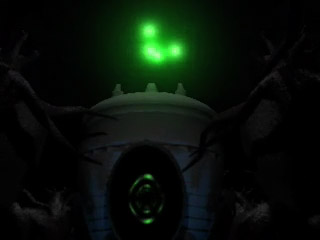you are here [x]: Scarlet Star Studios > the Scarlet Letters > lsgl: evolving act 2 scene 4
<< before
may 13: clowns & owls - with misha klein & dan ackerman
after >>
behind the scenes: Misha Klein and Stage 13
May 7, 2009
lsgl: evolving act 2 scene 4
by sven at 11:59 pm

Week 6 of 2nd quarter. The clip above is all new stuff that I put together this week. I'm really pleased with how the process went.
write out the list of events
I was feeling Act 2 Scene 4 was too sparse to make sense to an audience… So I went to my journal and wrote 20 pages to figure out what I needed to convey.
The key questions seem to be: What events occur? What info does the audience need? Understand the events, and the visuals will follow.
[That dictum's similar to an insight I had a while back about writing fiction: understand the events of your fantasy universe inside-and-out before trying to tell the story. Once you know the events from a God's eye view, then you'll have a much easier time choosing how to "curate" the tale for an audience.]
When you study the chain of events in detail, it's like seeing things transpire from all possible angles at once. The little details that reveal causation are what become most interesting. Ah-ha! I need to show the moment when the first Elder's soul leaves it's body… That's what motivates the lights to begin appearing over their machine!
camera work: the tourist and the tour guide
I'm toying around with this notion of "writing cinematography."
In the past I've approached thumbnailing primarily as a matter of framing nice visual compositions. That's a matter of drawing.
Now I'm shifting my attention more to the physical position of the camera, rather than what it sees. Whose eye level should it be at? Where is it coming from, and where is it going to? How fast is it moving? And why, why, why?
…That's a matter for writing.
Previously I've thought of the camera as an "invisible angel" witness that flits from place to place, but can't impact the events transpiring in the story. Now I'm grooving on the idea of the tourist and the tour guide.
It's like I'm in control of a magic flying platform, and I'm standing on it with a member of the audience… From the platform, I can freeze time, run time forward slo-mo, or travel through time in flashbacks and flash-forwards. Like some crazy ride at Disney or MGM, I'm escorting the audience around the room, directing their attention to little animatronic events that all add up to a story.
Control the experience by knowing exactly why each exhibit is being brought to their attention.
"ruff" iterations
Anyway, I came up with a nice 8-panel thumbnail storyboard. Every shot choice felt like it conveyed one or two pieces of vital info, and there was always a logic for where the camera would be located.
I took it to the studio, and using the from-rough-to-polished principle, I quickly made a bunch of stand-in shots… Which looked awful.
But that's OK! I did a second revision, which got closer to what I want. And then I did a third -- which is what you see above. It's still full of problems (to my eye) -- but I'm getting somewhere… And at a satisfying pace.
Had I decided to take my thumbnails and immediately transform them into polished shots, I'd be in a world of pain… Because I'd have invested a lot of time in getting them right, only to discover that they didn't work well together as a motion sequence.
the dialogue between roughs and thumbnails
Frankly, I'm beginning to question the need for creating polished storyboards at all. Every time I rough out new shots, I find myself thumbnailing the revisions. When there's an active dialogue between thumbnails and roughs, why over-work the board?
Granted, I'm laboring on a solo production, so I don't need boards as a communication tool… But my sense from hearing Michael Cachuela from Laika's story department speak (a year or two ago), is that this dialogue between thumbnails and roughs is actually how a big production's final storyboards come into being.
stopmo applications?
I'm interested in how I might apply writing cinematography + thumbnails + iterative roughs to future stopmo shorts.
My CG stuff is ridiculously complicated, with stampedes and multiple overlapping special effects -- stopmo usually only has 2 characters on screen at a time, tops. And they usually inhabit small, simple spaces.
But, I'm very interested in creating nuanced acting performances, where every action is motivated, and you can see lots of moments of thought process shining through the puppet. Perhaps iterations are the way to achieve that sort of fine detail?
Like Justin Rasch says, "hard work is the easy part." For me the soul-killer is floundering around not knowing what the hell I'm doing. Compared to that, a long conversation with myself and the journey of a thousand gentle corrections sounds like bliss.
posted by sven | May 7, 2009 11:59 PM | categories: let sleeping gods lie